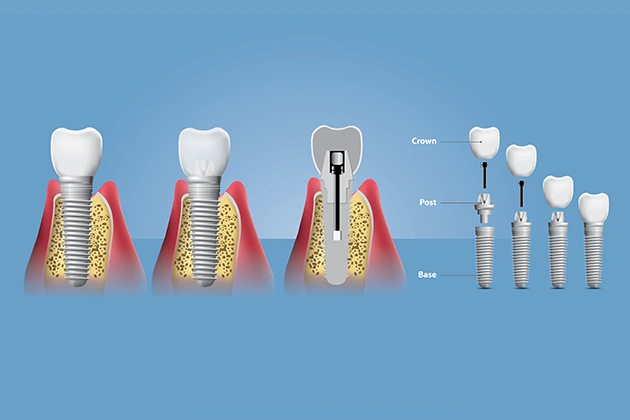Most people don’t think too deeply about the different names and functions of their teeth. But the next time you bite into a juicy apple, notice how you use your front teeth to bite and your back teeth to chew the fruit. Your back teeth or molars do the crucial work of breaking down the food you eat so it’s easy to digest. Cavities or tooth loss in the rear of your mouth can make enjoying your favorite foods much harder. That’s where molar implants come in. These artificial teeth are permanently attached to your jaw, so they look and feel just like natural teeth. Learn more about molar dental implants and follow our tips to keep them looking and feeling great for years.
What are molar dental implants?
Molars are the flat, ridged teeth at the very back of your mouth. Most healthy adults have a total of 12 molar teeth, that’s three on each end of their upper and lower jaws. Because your molars play such an important role in chewing and supporting your bite, it’s crucial to replace them when they’re damaged or decayed. Replacing missing molars with strong, stable implants can make a big difference in your comfort and oral health. Dental implants are posts or screws usually made of titanium or zirconia. They’re surgically placed into the jawbone where they can act as tooth roots. Once the implant integrates with your jawbone, it’s capped with a dental crown, bridge, or denture. Unlike removable dentures or bridges, implants are designed to last for a lifetime with good care.
Like natural teeth, dental implants require daily maintenance. Caring for them the right way will not only keep your implants strong but also protect your gums, jawbone, and surrounding teeth. Let’s take a closer look at what molar dental implants are and the steps you can take to make them last as long as possible.
How to help your molar implants last longer
Molar dental implants require more or less the same care you would give your normal teeth. This includes proper oral hygiene and the occasional dental check-up. Here are some proven ways to keep your molar implants in excellent condition:
Brush and floss daily
The molar region of your mouth is very prone to oral hygiene issues. Molar teeth have plenty of crevices and grooves that can trap food particles and plaque.1 While a molar implant can’t decay like a normal tooth, plaque build-up can still cause gum disease, which may affect the longevity of your implant. Brush your teeth twice a day with a soft-bristled toothbrush. Ensure you clean around the implant crown and gumline. Use a non-abrasive toothpaste to avoid damaging the dental crown. Spend a little extra time brushing your molar implants and make sure your toothbrush head is the right size and shape to reach every corner and crevice around your molar implants. Use floss, interdental brushes, or a water flosser to clean between the implant and adjacent teeth.
Schedule regular dental check-ups
Even if your implant feels fine, routine dental visits are critical. In a typical check-up, your dentist examines the implant, the surrounding gum tissue, and the supporting bone to check for signs of infection or gum disease. They may also check your implant stability. It’s a good idea to get check-ups every six months, though more frequent appointments make sense if you’re prone to gum issues.
Protect your implants from grinding and clenching
If you grind or clench your teeth (a condition known as bruxism), the added pressure can damage implants over time. The crown may chip or crack, and the implant may come loose. Your dentist may recommend a custom night guard if you suspect you grind your teeth while sleeping. Wearing a protective guard helps reduce strain on your molar implants and natural teeth.2
Monitor changes and act quickly
Pay attention to any changes around your implant site. If you notice swelling, bleeding, discomfort, or loosening of the implant crown, contact your dentist immediately. Early treatment can prevent minor issues from becoming serious problems.
Molar dental implants are more prone to problems like plaque build-up or damage from bruxism. These issues are also common in the molar region for people with all-on-4 dental implants. This is why it’s important to pay extra attention to your molars when you’re brushing or flossing. The long-term success of dental implants depends on how well you care for them. So, give them the best care for results that last a lifetime.
Sources:
1 Gold Coast Family Dental – Why Do Molars Seem to Get More Cavities?
2 Dental Care Center at Kennestone – Teeth Grinding and Dental Implants: How to Protect Your Investment While You Sleep










